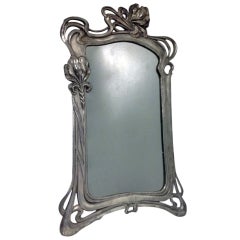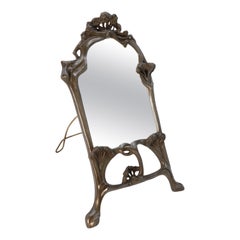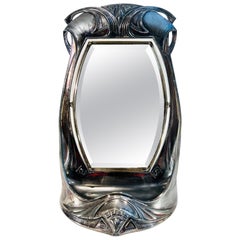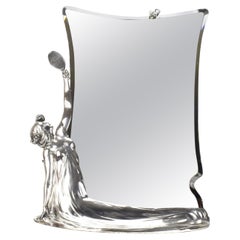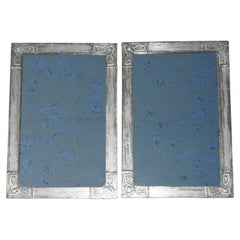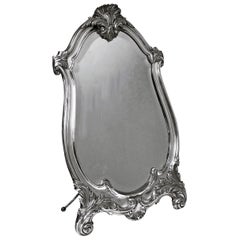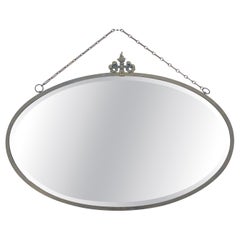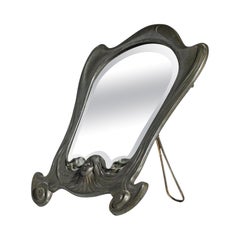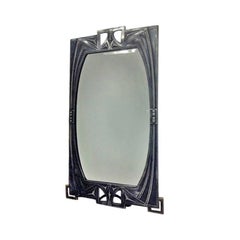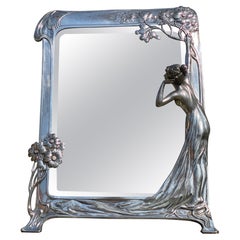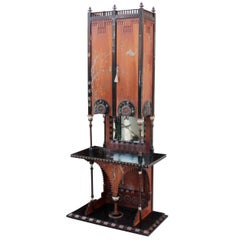Art Nouveau Pewter Mirror
Antique Late 19th Century Art Nouveau Vanity Items
Early 20th Century German More Furniture and Collectibles
Metal
Antique Late 19th Century Art Nouveau Table Mirrors
Pewter
Antique Early 1900s French Art Nouveau Table Mirrors
Pewter
Early 20th Century German Jugendstil Table Mirrors
Pewter
Antique Early 1900s German Art Nouveau Table Mirrors
Pewter
Antique Early 1900s German Art Nouveau Table Mirrors
Silver Plate, Pewter
Early 20th Century English Art Nouveau Wall Mirrors
Pewter
Antique Early 1900s Art Nouveau Table Mirrors
Silver Plate
20th Century American Hollywood Regency Wall Mirrors
Pewter
Vintage 1920s German Art Nouveau Table Mirrors
Pewter
Early 20th Century German Jugendstil Table Mirrors
Pewter
Vintage 1920s Swedish Art Nouveau Wall Mirrors
Pewter
Antique Early 1900s German Art Nouveau Centerpieces
Pewter
Antique Late 19th Century German Art Nouveau Vanity Items
Recent Sales
Antique Early 1900s German Art Nouveau Picture Frames
Silver, Pewter
Antique 1880s Italian Art Nouveau Cabinets
Copper, Pewter
Early 2000s French Art Nouveau Table Mirrors
Pewter
Early 20th Century Arts and Crafts More Mirrors
Pewter
Antique 1890s German Art Nouveau Table Mirrors
Pewter
Early 20th Century German Art Nouveau Wall Mirrors
Pewter
Antique Early 1900s German Art Nouveau Table Mirrors
Pewter
Early 20th Century German Table Mirrors
Pewter
Early 20th Century German Art Nouveau Table Mirrors
Metal, Silver, Pewter
Vintage 1930s Spanish Art Nouveau Mantel Mirrors and Fireplace Mirrors
Pewter, Silver Leaf
Early 20th Century French Art Nouveau Table Mirrors
Pewter
Antique Early 1900s French Art Nouveau Sheffield and Silverplate
Pewter
Antique Early 1900s Italian Art Nouveau Corner Cupboards
Metal, Copper, Pewter
Vintage 1920s Dutch Art Nouveau Table Mirrors
Pewter
Early 20th Century German Art Nouveau Wall Mirrors
Pewter
1990s French Art Nouveau Pier Mirrors and Console Mirrors
Composition, Pewter
Antique Early 1900s German Art Nouveau Table Mirrors
Pewter, Silver Plate
Early 20th Century German Art Nouveau Table Mirrors
Early 20th Century German Art Nouveau Table Mirrors
Pewter
Early 20th Century German Art Nouveau Table Mirrors
Pewter
People Also Browsed
Early 20th Century Austrian Vienna Secession Beds and Bed Frames
Bentwood
Vintage 1950s French Hollywood Regency Table Lamps
Metal
Vintage 1930s Art Deco Armchairs
Fabric, Beech, Bentwood
Antique Late 19th Century English Art Nouveau Windows
Glass, Stained Glass
Antique 1860s Victorian Sofas
Mahogany
Vintage 1920s Czech Art Deco Lounge Chairs
Velvet, Oak
Mid-20th Century Mid-Century Modern Beds and Bed Frames
Wood
Antique 19th Century Chaise Longues
Mahogany
20th Century French Art Nouveau Armchairs
Textile, Mahogany
Vintage 1930s European Art Deco Armchairs
Walnut
2010s British Art Deco Lounge Chairs
Alpaca, Beech, Oak
Antique Late 19th Century French Louis XVI Canapes
Velvet, Wood
Vintage 1930s French Art Deco Daybeds
Wood
Early 20th Century Austrian Jugendstil Lounge Chairs
Leather, Beech
Early 20th Century French Art Nouveau Side Tables
Wood
Vintage 1960s French Hollywood Regency Wall Lights and Sconces
Composition
Art Nouveau Pewter Mirror For Sale on 1stDibs
How Much is a Art Nouveau Pewter Mirror?
A Close Look at Art-nouveau Furniture
In its sinuous lines and flamboyant curves inspired by the natural world, antique Art Nouveau furniture reflects a desire for freedom from the stuffy social and artistic strictures of the Victorian era. The Art Nouveau movement developed in the decorative arts in France and Britain in the early 1880s and quickly became a dominant aesthetic style in Western Europe and the United States.
ORIGINS OF ART NOUVEAU FURNITURE DESIGN
- Emerged during the late 19th century
- Popularity of this modernizing style declined in the early 20th century
- Originated in France and Britain but variants materialized elsewhere
- Informed by Rococo, Pre-Raphaelite art, Japanese art (and Japonisme), Arts and Crafts; influenced modernism, Bauhaus
CHARACTERISTICS OF ART NOUVEAU FURNITURE DESIGN
- Sinuous, organic and flowing lines
- Forms that mimic flowers and plant life
- Decorative inlays and ornate carvings of natural-world motifs such as insects and animals
- Use of hardwoods such as oak, mahogany and rosewood
ART NOUVEAU FURNITURE DESIGNERS TO KNOW
ANTIQUE ART NOUVEAU FURNITURE ON 1STDIBS
Art Nouveau — which spanned furniture, architecture, jewelry and graphic design — can be easily identified by its lush, flowing forms suggested by flowers and plants, as well as the lissome tendrils of sea life. Although Art Deco and Art Nouveau were both in the forefront of turn-of-the-20th-century design, they are very different styles — Art Deco is marked by bold, geometric shapes while Art Nouveau incorporates dreamlike, floral motifs. The latter’s signature motif is the "whiplash" curve — a deep, narrow, dynamic parabola that appears as an element in everything from chair arms to cabinetry and mirror frames.
The visual vocabulary of Art Nouveau was particularly influenced by the soft colors and abstract images of nature seen in Japanese art prints, which arrived in large numbers in the West after open trade was forced upon Japan in the 1860s. Impressionist artists were moved by the artistic tradition of Japanese woodblock printmaking, and Japonisme — a term used to describe the appetite for Japanese art and culture in Europe at the time — greatly informed Art Nouveau.
The Art Nouveau style quickly reached a wide audience in Europe via advertising posters, book covers, illustrations and other work by such artists as Aubrey Beardsley, Henri de Toulouse-Lautrec and Alphonse Mucha. While all Art Nouveau designs share common formal elements, different countries and regions produced their own variants.
In Scotland, the architect Charles Rennie Mackintosh developed a singular, restrained look based on scale rather than ornament; a style best known from his narrow chairs with exceedingly tall backs, designed for Glasgow tea rooms. Meanwhile in France, Hector Guimard — whose iconic 1896 entry arches for the Paris Metro are still in use — and Louis Majorelle produced chairs, desks, bed frames and cabinets with sweeping lines and rich veneers.
The Art Nouveau movement was known as Jugendstil ("Youth Style") in Germany, and in Austria the designers of the Vienna Secession group — notably Koloman Moser, Josef Hoffmann and Joseph Maria Olbrich — produced a relatively austere iteration of the Art Nouveau style, which mixed curving and geometric elements.
Art Nouveau revitalized all of the applied arts. Ceramists such as Ernest Chaplet and Edmond Lachenal created new forms covered in novel and rediscovered glazes that produced thick, foam-like finishes. Bold vases, bowls and lighting designs in acid-etched and marquetry cameo glass by Émile Gallé and the Daum Freres appeared in France, while in New York the glass workshop-cum-laboratory of Louis Comfort Tiffany — the core of what eventually became a multimedia decorative-arts manufactory called Tiffany Studios — brought out buoyant pieces in opalescent favrile glass.
Jewelry design was revolutionized, as settings, for the first time, were emphasized as much as, or more than, gemstones. A favorite Art Nouveau jewelry motif was insects (think of Tiffany, in his famed Dragonflies glass lampshade).
Like a mayfly, Art Nouveau was short-lived. The sensuous, languorous style fell out of favor early in the 20th century, deemed perhaps too light and insubstantial for European tastes in the aftermath of World War I. But as the designs on 1stDibs demonstrate, Art Nouveau retains its power to fascinate and seduce.
There are ways to tastefully integrate a touch of Art Nouveau into even the most modern interior — browse an extraordinary collection of original antique Art Nouveau furniture on 1stDibs, which includes decorative objects, seating, tables, garden elements and more.
Finding the Right Mirrors for You
The road from early innovations in reflective glass to the alluring antique and vintage mirrors in trendy modern interiors has been a long one but we’re reminded of the journey everywhere we look.
In many respects, wall mirrors, floor mirrors and full-length mirrors are to interior design what jeans are to dressing. Exceedingly versatile. Universally flattering. Unobtrusively elegant. And while all mirrors are not created equal, even in their most elaborate incarnation, they're still the heavy lifters of interior design, visually enlarging and illuminating any space.
We’ve come a great distance from the polished stone that served as mirrors in Central America thousands of years ago or the copper mirrors of Mesopotamia before that. Today’s coveted glass Venetian mirrors, which should be cleaned with a solution of white vinegar and water, were likely produced in Italy beginning in the 1500s, while antique mirrors originating during the 19th century can add the rustic farmhouse feel to your mudroom that you didn’t know you needed.
By the early 20th century, experiments with various alloys allowed for mirrors to be made inexpensively. The geometric shapes and beveled edges that characterize mirrors crafted in the Art Deco style of the 1920s can bring pizzazz to your entryway, while an ornate LaBarge mirror made in the Hollywood Regency style makes a statement in any bedroom. Friedman Brothers is a particularly popular manufacturer known for decorative round and rectangular framed mirrors designed in the Rococo, Louis XVI and other styles, including dramatic wall mirrors framed in gold faux bamboo that bear the hallmarks of Asian design.
Perhaps unsurprisingly, mid-century modernism continues to influence the design of contemporary mirrors. Today’s simple yet chic mantel mirror frames, for example, often neutral in color, owe to the understated mirror designs introduced in the postwar era.
Sculptor and furniture maker Paul Evans had been making collage-style cabinets since at least the late 1950s when he designed his Patchwork mirror — part of a series that yielded expressive works of combined brass, copper and pewter — for Directional Furniture during the mid-1960s. Several books celebrating Evans’s work were published beginning in the early 2000s, as his unconventional furniture has been enjoying a moment not unlike the resurgence that the Ultrafragola mirror is seeing. Designed by the Memphis Group’s Ettore Sottsass in 1970, the Ultrafragola mirror, in all its sensuous acrylic splendor, has become somewhat of a star thanks to much-lauded appearances in shelter magazines and on social media.
On 1stDibs, we have a broad selection of vintage and antique mirrors and tips on how to style your contemporary mirror too.

